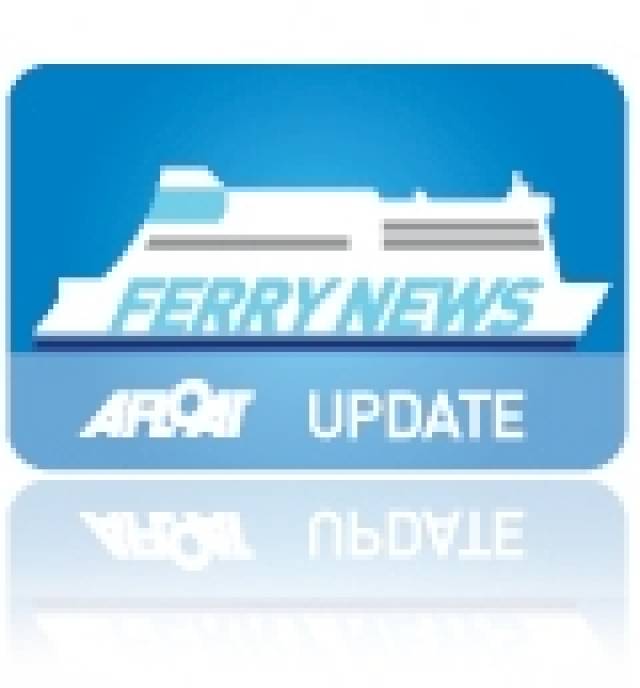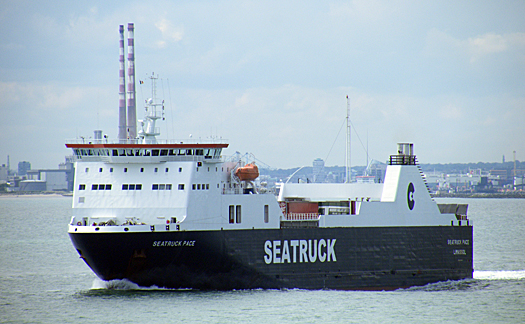#FerryCaptainInterview - Starting from last weekend is our new series of interviews with Irish Sea ferry captains. Jehan Ashmore talks to Captain Phil Ankers, master of Seatruck Ferries 'P' class ferry freight, Seatruck Pace which in late April entered service on the Dublin Port-Heysham service.
The larger 110 trailer-unit vessel replaces a smaller vessel on the route linking the capital and Lanchashire port. Her introduction also brings enhanced facilities for driver-accompanied trucks on the eight hour Ireland-UK link and offering 16 weekly departures to meet the demands of hauliers.
Before her recent return to Irish Sea, the vessel built as one of a quartet for Seatruck Ferries, had been chartered to Bluwater Shipping A/S to transport wind-farm components from Esbjerg in Denmark for the construction of the Gwynt y Môr Offshore Wind Farm off north Wales.
What set your interest to choose a seafaring career?
There had been seafaring in the family but it skipped a generation with my father, before him there had been two generations of marine engineers!
Name the colleges and or academies to where you studied seamanship courses?
For first certificate (2nd Mates) I studied in Riversdale College in Liverpool then for mates and masters, I studied in Liverpool Polytechnic.
Did any of these educational institutions involve using a training ship? or a stint of service on board a vessel as part of the programme module?
To get 2nd Mates you required 18 months sea service so we had 2 x 6-months in college and the rest spent at sea.
Seatruck Pace on her morning sailing departing Dublin Bay bound for Heysham in Lancashire
Upper-deck of the 110 freight-unit (2,930 lane metres) larger 'P' class vessel which was introduced on the Irish Sea route in late April
What was the most interesting and also the most challenging aspect of your studying?
Ocean fleets traded worldwide so there was a good variety of interesting runs. Star sights were probably the more satisfying part, learning all law and construction was challenging.
For what reasons did you like a career in deep-sea and what ship was the most rewarding?
At the time you could go away to see the world as you had a little port time and shore-leave to do so. My first voyage to the Far East on 'Ascanus' then 'Glenlyon' were very good.
How many un-accompanied trailers can be handled (types of cargo) on the freight decks?
In total there are 116-trailers or 10 trucks and 12 self-drives (cars or lorries).
Since refurbishment upgrade, what facilities have improved for truck ferries and private motorists?
These Point ('P' ) class ships have offered very good facilities since launch, having private cabins with own-shower's +T.V. in addition a good drivers' mess lounge. The new FSG class of the 'Power' and 'Progress' are now much improved as they have privacy curtains and no bunk beds.
What nationalities make up the crew and how many are there in total between change of rosters?
On here we have 3, masters are British, chief officers are Estonian and all other ratings are also of the same nationality. In total we have 40 members of crew.
On average what is the speed of the vessel on the Irish Sea route?
Around 15 knots, the ship can achieve up to 20 knots but we average approximately 15 knots for economy service.
In terms of fuel, what capacity is consumed on each passage and how often do you need to take on bunkers?
The vessel consumes between 9 and 16 tonnes depending on one or two engine passages.
How often do you go on leave while your fellow counterpart relieves you on duty?
We work 2 weeks on 2 weeks off and this changes to 3 on and 3 off during the summer months.
What aspects do you enjoy the most on the freight-only service?
I have enjoyed passenger runs as well but we can give a more one-to-one service on this route for our 12 passengers, which can be for driver-accompanied trucks, private car motorists and those taking motorhomes.
How well suited is this ro-pax on the route and her sea-keeping handling?
This vessel is well suited to Irish Sea conditions.
Captain Phil Ankers on the bridge approaching berth at Dublin Port and a 'FSG' class ship serving Seatruck's route to Liverpool


































































